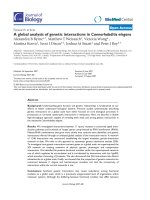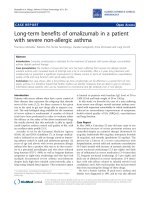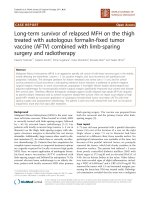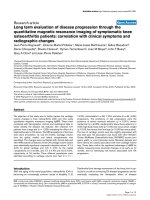Báo cáo sinh học: "Long term physiologic modification using rAAV in utero gene-therapy" doc
Bạn đang xem bản rút gọn của tài liệu. Xem và tải ngay bản đầy đủ của tài liệu tại đây (971.71 KB, 7 trang )
BioMed Central
Page 1 of 7
(page number not for citation purposes)
Genetic Vaccines and Therapy
Open Access
Research
Long term physiologic modification using rAAV in utero
gene-therapy
Deiadra J Garrett
1,2
, J Craig Cohen*
2
and Janet E Larson
1
Address:
1
Ochsner Children's Research Institute, Ochsner Clinic Foundation, New Orleans, LA 70121, USA and
2
Departments of Medicine,
Biochemistry, and Genetics, Louisiana State University Health Sciences Center, New Orleans, LA 70112, USA
Email: Deiadra J Garrett - ; J Craig Cohen* - ; Janet E Larson -
* Corresponding author
Abstract
Background: Transfer of genes in utero via the amniotic fluid was shown previously with
recombinant adeno-associated viruses (rAAV) to be highly efficient. Expression for over one year
was demonstrated using reporter genes. In addition, it was shown previously that transgenes
delivered by this method release protein into the general circulation. Given these results
experiments were designed to test the hypothesis that in utero rAAV gene therapy could result in
long term physiologic modification.
Methods: A rAAV recombinant expressing ciliary neurotrophic factor (cntf) and green fluorescent
(gfp) in a polycistronic messenger was used to treat rat fetuses in utero. CNTF causes weight loss
and decreased water consumption as a measurable physiologic effect. GFP was used as a marker
of gene expression.
Results: In utero gene transfer with rAAV carrying human cntf and gfp resulted in long-term gene
expression in rat. CNTF-specific physiologic effects of a decrease in weight and water intake were
obtained. Expression of the GFP was documented in the treated animals at one year of age.
Conclusion: Given this data, in utero gene therapy with rAAV into multipotential stem cells
resulted in long term systemic physiologic modification of the treated animals by the transgene
product. In utero rAAV gene therapy potentially could be used for gene replacement therapy in
metabolic disorders.
Background
In utero gene transfer is a successful method to transfer
genes to the developing fetus. Providing a therapeutic
gene to the developing fetus allows for the treatment of
genetic defects before the comorbidities of the disease
results. Many genetic diseases can be detected in utero;
therefore, treating these diseases prior to birth could prove
beneficial. The fetus provides a unique environment for
gene transfer because we can influence differentiation and
proliferation of target cells and in addition we are able to
bypass the immune system because our vectors are not
seen as foreign in the immature immune system of the
fetus [1]. Our laboratory has proven that in utero gene
transfer via amniotic fluid is an effective method to intro-
duce genes into multipotential stem cells into three spe-
cies; the mouse, the rat and the rhesus primate [2-6]. Gene
transfer is performed at 16–17 days gestation in rodents,
which is comparable to that of a 10–20 week human ges-
tation. During this critical time of development, undiffer-
entiated epithelial cells line the lung and intestine. These
Published: 19 May 2004
Genetic Vaccines and Therapy 2004, 2:4
Received: 04 February 2004
Accepted: 19 May 2004
This article is available from: />© 2004 Garrett et al; licensee BioMed Central Ltd. This is an Open Access article: verbatim copying and redistribution of this article are permitted in all
media for any purpose, provided this notice is preserved along with the article's original URL.
Genetic Vaccines and Therapy 2004, 2 />Page 2 of 7
(page number not for citation purposes)
cells are the targets for our vectors. Organ development
and growth continues after the infection and the differen-
tiated daughters of the targeted cells continue to express
the transgene.
The vector used in this experiment was adeno-associated
virus which has shown much promise as a gene therapy
tool [7-9]. Adeno-associated virus is a nonpathogenic par-
vovirus which consists of single-stranded DNA molecule
with 4,680 nucleotides. The rAAV genome contains rep
and cap genes which encode for the proteins involved in
replication and capsid formation. These genes are flanked
by viral inverted terminal repeats which are 145 bases in
length and form a T-type configuration [10]. Interestingly,
rAAV vectors only need the inverted terminal repeats in cis
for replication, packaging and integration [11-14]. There
are 6 serotypes of rAAV which differ in their capsid pro-
teins and thus their tropism for different target cells. rAAV-
2 is the most common serotype used in gene therapy
experiments and is the one used in this experiment.
There are several features that make rAAV an attractive vec-
tor for gene therapy protocols. First, rAAV has the ability
to remain expressed throughout the full life cycle of a cell
by integrating into host cell DNA or remaining episomal
inside the cell. Wild-type adeno-associated virus has been
shown to integrate into chromosome 19 in the host cell
by non-homologous recombination mediated by the rep
gene products which are part of the rAAV genome [15,11].
Recombinant rAAV which lacks the rep gene has been
shown to integrate nonspecifically into host cell DNA or
remain episomal. In either case, the rAAV genome is per-
sistently expressed using the host cell's machinery [16].
This feature is important in gene therapy because it could
allow for a single injection of a therapeutic gene without
the need for re-administrations. It is well known that
repeat administrations of a vector can lead to neutralizing
antibodies against the transgene rendering it ineffective.
Secondly, rAAV has broad transduction capabilities
because it is able to transduce many cell types including
the lungs, neurons, muscle, intestine and hematopoietic
cells [17]. In addition, rAAV can transduce mitotic and
postmitotic cells [14]. At the time of our injection, we
know that the stem cells in the lung and intestine are
undergoing rapid differentiation and proliferation and
therefore are easily able to be transduced by rAAV. Third,
rAAV is an attractive vector because it is safe as compared
to other viral vectors. 96% of the genome is removed
when preparing rAAV vectors because only the inverted
terminal repeats are needed for viral replication, packag-
ing and integration. In addition, for rAAV to enter the lytic
phase of its life cycle it requires infection with a helper
virus such as adenovirus or herpes simplex virus. Other-
wise, it remains latent inside the host cell. Others have
reported the use of rAAV for in utero gene therapy experi-
ments and have shown long-term expression of the trans-
gene product in target tissues for 3 months to 18 months
[18]. Recently, this laboratory demonstrated in long term
expression of rAAV vectored transgenes in multiple spe-
cies [19].
Ciliary neurotrophic factor (CNTF), a biologically active
gene, was used in this experiment to demonstrate physio-
logic changes in our laboratory animals after in utero gene
transfer. CNTF is a well-known nerve growth factor which
promotes survival and differentiation of neurons. In addi-
tion, CNTF promotes weight loss and a decrease in water
intake in laboratory animals when given systemically [20-
23]. Weight loss in CNTF-treated animals is secondary to
a decrease in skeletal muscle, adipose tissue, glucose and
triglycerides.
Materials and methods
In utero gene transfer
At 15–16 days gestation, timed-pregnant Sprague-Dawley
rats (Harlan-Sprague-Dawley, Indianapolis, IN) were
anesthetized and the fetuses surgically exposed for injec-
tion via amniotic fluid with replication defective rAAV.
Three different doses of the replication defective rAAV vec-
tors were injected: high, medium and low dose groups
with 2.5 × 10
9
pfu/ml, 2.5 × 10
8
pfu/ml and 2.5 × 10
7
pfu/
ml of virus, respectively. The control fetuses were not
injected.
Virus
The construct used in this experiment was rAAVcntf-gfp,
an rAAV recombinant carrying the cntf and gfp genes with
a cytomegalovirus promoter. There was an internal ribos-
ome entry site (IRES sequence) placed between the two
transgenes. The construct was shown to produce a polycis-
tronic message, thus production of the CNTF and GFP
protein are co-expressed [24].
Measurement of weight, water intake and food intake
A total of 39 rat pups were studied over six months. The
high dose group included 9 animals (5 males, 4 females);
the medium dose group, 15 (7 males, 8 females); the low
dose group, 6 (3 males, 3 females); and the control group,
9 (6 males, 3 females).
Weight in grams was measured at day of life 10, 30, 50,
90, 114 and 120. Water intake was measured in milliliters
over an eight week period at day of life 90, 97, 104, 111,
118, 125, 132 and 139. Food intake was measured in
grams over an eight week period of time at day of life 90,
97, 104, 111, 118, 132 and 139.
Analysis of variance (ANOVA) with repeated measures
was used for statistical analyses. All males and females
Genetic Vaccines and Therapy 2004, 2 />Page 3 of 7
(page number not for citation purposes)
underwent the same protocol. Males and females were
analyzed separately.
Western Blot analysis
Protein was extracted from lung tissue samples using 10
times volume 1X Laemmli sample buffer with 100 mM
PMSF, sonicated, boiled and the supernatant was aliquot-
ted into new tubes. Protein determination was done using
the Sigma Kit with bicinchomnic acid Solution and cop-
per (II) sulfate pentahydrate (50:1). Samples were placed
in a spectrophotometer and protein concentration was
determined. 20 micrograms of protein from each sample
was placed on a 10% SDS-PAGE gel and run at a constant
current of 30 mA. The proteins were then transferred to a
nitrocellulose membrane using a semi-dry electroblotter
at 10–14 volts for 1–2 hours. The western blot protocol
was ECL from Amersham Life Sciences. First, the mem-
brane was blocked overnight with 5% Blotto at 4°C. In
the morning, the membrane was washed with 10 mm
Tris-borate, 0.15 M NaCl (TBS)-Tween (0.1%) and pri-
mary rabbit anti-GFP was allowed to incubate with mem-
brane for three hours. This was followed by a second wash
step with TBS-Tween (0.1%) and then incubation with a
peroxidase-conjugated anti-rabbit. The membrane was
washed, incubated with ECL reagents, and exposed to X-
ray film. Equal loading of samples was confirmed by using
alpha-tubulin.
Results
Effect of in utero rAAVcntf-gfp on weight
CNTF reduces weight as a primary effect on the physiology
in mature animals. Thus, animals treated in utero with the
rAAVcntf-gfp construct at 15–16 days gestation were
weighed at regular intervals. Three different doses of virus
were used varying from 2.5 × 10
7
–10
9
pfu/ml of amniotic
fluid. As shown in Fig. 1, both females and males demon-
strated a statistically significant difference, <0.0001 and
<0.005, respectively in weight throughout the six months
in the treated animals compared to controls. For males,
the difference in weight began at 90 days. In contrast, a
difference in female weights was observed at 50 days.
Clinically, for both males and females, the response in
gene expression was dose-dependent with the greatest
inhibition at the high dose and least inhibition at the low
dose.
Water intake in rAAVcntf-gfp treated animals
During the course of these experiments it was noted that
the treatment group appeared to consume less water than
the control animals. Thus, over a 7 week period beginning
at 111 days of age, water intake in control and treatment
groups was measured on a weekly basis. The difference in
water intake in females compared to controls was statisti-
cally significant at a significance level at all doses at a p =
0.001 (Figure 2A). In contrast, a dose dependent water
intake effect was noted in males (Fig. 2B). Only the
medium and high doses of rAAVcntf-gfp therapy yielded
statistically significant decreases in water intake (p <
0.0001). A similar dose response was noted in females, as
well. Food intake was measured during the same time
period as water intake and no statistically significant dif-
ference was observed between treatment groups.
Long term maintenance of GFP expression
Because rat and human CNTF might cross-react, expres-
sion of the viral transgenes was documented using GFP
levels from the polycistronic mRNA produced from the
rAAVcntf-gfp construct. As shown in Fig. 3, GFP was read-
ily demonstrated in protein extracts from the lung. In
addition, GFP was found in the kidney where it is filtered
from the circulation (data not shown). These results are
consistent with our previous published report [19] dem-
onstrating long term expression of transgene following in
utero rAAV gene transfer.
Discussion
In utero gene transfer is a proven model for effective gene
transfer and expression [1-3,5]. Currently, researchers in
the field of gene therapy are attempting to develop tech-
niques to transfer genes to somatic cells and provide long-
term genetic expression. Previously, we demonstrated that
in utero rAAV gene therapy could sustain expression of
transgenes for over 1 year in mice rats, and primates. Data
presented in this paper demonstrated that in utero gene
transfer with rAAV provides systemic physiologic effects of
our transgene product and long-term expression of
genetic information. This is clearly evident by using a bio-
logically active gene and observing weight loss and a
decrease in water intake in our treated rats compared to
our controls over a six month period of time. We did not
observe a significant difference in food intake in CNTF-
treated pups as compared to controls. This is consistent
with previously published reports involving the systemic
administration of CNTF [20-23]. In these experiments,
CNTF-treated rodents demonstrated a decrease in weight
and water intake but no significant difference in food
intake as compared to controls.
Given these data and our previous reported long term
expression of reporter genes using rAAV [19], this method
of in utero gene transfer with rAAV can be useful in treating
metabolic diseases by providing long-term gene expres-
sion. A number of experiments involving in utero gene
transfer with rAAV, however, have not resulted in signifi-
cant long term expression for a number of reasons. Boyle
et al. [25] demonstrated gene transfer into rabbit pulmo-
nary epithelium using rAAV which lasted only 24 days.
Their observed short term expression can be attributed to
injection of the fetuses during the late saccular phase of
lung development which the authors acknowledge in
Genetic Vaccines and Therapy 2004, 2 />Page 4 of 7
(page number not for citation purposes)
Effect of in utero rAAVcntf-gfp on weight gain in ratsFigure 1
Effect of in utero rAAVcntf-gfp on weight gain in rats. Rats were treated in utero with an rAAVcntf-gfp at 16 days gesta-
tion with high (n = 9; RED), medium (n = 22; ORANGE) and low (n = 6; YELLOW) doses of rAAVcntf-gfp as described in
Materials and Methods. Control (n = 9; BLACK) animals were untreated. After weaning at 30 days of age individual animals
were weighed. Data are presented as the mean ± standard deviation. Top panel – females; Bottom panel – males
Genetic Vaccines and Therapy 2004, 2 />Page 5 of 7
(page number not for citation purposes)
Effect of in utero rAAVcntf-gfp on water intake in ratsFigure 2
Effect of in utero rAAVcntf-gfp on water intake in rats. Rats were treated in utero with an rAAVcntf-gfp at 16 days ges-
tation with high (n = 9; RED), medium (n = 22; ORANGE) and low (n = 6; YELLOW) doses of rAAVcntf-gfp as described in
Materials and Methods. Control (BLACK) animals were untreated. Water intake was measure weekly. Data are presented as
the mean ± standard deviation. Top panel – females; Bottom panel – males
Genetic Vaccines and Therapy 2004, 2 />Page 6 of 7
(page number not for citation purposes)
their paper. We have clearly demonstrated in this paper
and previous work that the optimal time for in utero gene
transfer is during early lung development in order to opti-
mize the number of undifferentiated stem cells present in
the pulmonary and intestinal epithelium which promotes
vector uptake and gene expression. This time point is dur-
ing the early cannalicular period of lung development
which occurs at 15–16 days in rodents and at 10–20
weeks gestation in humans.
Conclusion
In utero rAAV gene therapy can be used to achieve long
term expression of metabolically active genes. As shown
previously [19], these gene products are released into the
general circulation to elicit a sustained physiologic effect.
Therapeutic applications to human metabolic disorders
diagnosed in utero may be feasible.
Competing interests
None declared.
Authors' contributions
JCC and JEL conceived and carried out all experiments in
the project. DJG performed all the experiments.
Acknowledgements
This work was supported by funds provided by the Ochsner Clinic
Foundation.
References
1. Sekhon HS, Larson JE: In utero gene transfer into the pulmo-
nary epithelium. Nat Med 1995, 1:1201-1203.
2. Larson JE, Morrow SL, Happel L, Sharp JF, Cohen JC: Reversal of
cystic fibrosis phenotype in mice by gene therapy in utero.
Lancet 1997, 349:619-620.
3. Morrow SL, Larson JE, Nelson S, Sekhon HS, Ren T, Cohen JC: Mod-
ification of development by the CFTR gene in utero. Mol Genet
Metab 1998, 65:203-212.
4. Cohen JC, Morrow SL, Cork RJ, Delcarpio JB, Larson JE: Molecular
pathophysiology of cystic fibrosis based on the rescued
knockout mouse model. Mol Genet Metab 1998, 64:108-118.
5. Larson JE, Morrow SL, Delcarpio JB, Bohm RP, Ratterree MS, Blan-
chard JL, Cohen JC: Gene transfer into the fetal primate: evi-
dence for the secretion of transgene product. Mol Ther 2000,
2:631-639.
6. Larson JE, Delcarpio JB, Farberman MM, Morrow SL, Cohen JC:
CFTR modulates lung secretory cell proliferation and
differentiation. Am J Physiol Lung Cell Mol Physiol 2000, 279:L333-41.
7. Kay MA, Glorioso JC, Naldini L: Viral vectors for gene therapy:
the art of turning infectious agents into vehicles of
therapeutics. Nat Med 2001, 7:33-40.
8. Bueler H: Adeno-associated viral vectors for gene transfer
and gene therapy. Biol Chem 1999, 380:613-622.
9. Flotte TR, Carter BJ: Adeno-associated virus vectors for gene
therapy. Gene Ther 1995, 2:357-362.
10. Srivastava A, Lusby EW, Berns KI: Nucleotide sequence and
organization of the adeno-associated virus 2 genome. J Virol
1983, 45:555-564.
11. Kotin RM, Linden RM, Berns KI: Characterization of a preferred
site on human chromosome 19q for integration of adeno-
associated virus DNA by non-homologous recombination.
Embo J 1992, 11:5071-5078.
12. Muzyczka N: Use of adeno-associated virus as a general trans-
duction vector for mammalian cells. Curr Top Microbiol Immunol
1992, 158:97-129.
13. Berns KI, Giraud C: Biology of adeno-associated virus. Curr Top
Microbiol Immunol 1996, 218:1-23.
14. Rabinowitz JE, Samulski J: Adeno-associated virus expression
systems for gene transfer. Curr Opin Biotechnol 1998, 9:470-475.
15. Kotin RM, Siniscalco M, Samulski RJ, Zhu XD, Hunter L, Laughlin CA,
McLaughlin S, Muzyczka N, Rocchi M, Berns KI: Site-specific inte-
gration by adeno-associated virus. Proc Natl Acad Sci U S A 1990,
87:2211-2215.
16. Duan D, Sharma P, Dudus L, Zhang Y, Sanlioglu S, Yan Z, Yue Y, Ye
Y, Lester R, Yang J, Fisher KJ, Engelhardt JF: Formation of adeno-
associated virus circular genomes is differentially regulated
by adenovirus E4 ORF6 and E2a gene expression. J Virol 1999,
73:161-169.
17. Monahan PE, Samulski RJ, Tazelaar J, Xiao X, Nichols TC, Bellinger
DA, Read MS, Walsh CE: Direct intramuscular injection with
recombinant AAV vectors results in sustained expression in
a dog model of hemophilia. Gene Ther 1998, 5:40-49.
18. Lipshutz GS, Gruber CA, Cao Y, Hardy J, Contag CH, Gaensler KM:
In utero delivery of adeno-associated viral vectors: intraperi-
toneal gene transfer produces long-term expression. Mol Ther
2001, 3:284-292.
19. Garrett DJ, Larson JE, Dunn D, Marrero L, Cohen JC: In utero
recombinant adeno-associated virus gene transfer in mice,
rats, and primates. BMC Biotechnol 2003, 3:16.
20. Kalra SP, Xu B, Dube MG, Moldawer LL, Martin D, Kalra PS: Leptin
and ciliary neurotropic factor (CNTF) inhibit fasting-induced
suppression of luteinizing hormone release in rats: role of
neuropeptide Y. Neurosci Lett 1998, 240:45-49.
21. Xu B, Dube MG, Kalra PS, Farmerie WG, Kaibara A, Moldawer LL,
Martin D, Kalra SP: Anorectic effects of the cytokine, ciliary
neurotropic factor, are mediated by hypothalamic neu-
ropeptide Y: comparison with leptin. Endocrinology 1998,
139:466-473.
22. Matthys P, Billiau A: Cytokines and cachexia. Nutrition 1997,
13:763-770.
23. Lambert PD, Anderson KD, Sleeman MW, Wong V, Tan J, Hijarun-
guru A, Corcoran TL, Murray JD, Thabet KE, Yancopoulos GD, Wie-
gand SJ: Ciliary neurotrophic factor activates leptin-like
pathways and reduces body fat, without cachexia or rebound
weight gain, even in leptin-resistant obesity. Proc Natl Acad Sci
U S A 2001, 98:4652-4657.
24. Liang FQ, Dejneka NS, Cohen DR, Krasnoperova NV, Lem J, Maguire
AM, Dudus L, Fisher KJ, Bennett J: AAV-mediated delivery of cil-
Expression of GFP in lungs at one year of age following in utero rAAVcntf-gfp gene therapyFigure 3
Expression of GFP in lungs at one year of age follow-
ing in utero rAAVcntf-gfp gene therapy. Rats were
treated at 16 days gestation with rAAVcntf-gfp at high (2.5 ×
10
9
), medium (2.5 × 10
8
) and low (2.5 × 10
7
) pfu/ml doses.
Lungs were harvested at 1 year of age and GFP-specific pro-
tein identified by western blot
Publish with BioMed Central and every
scientist can read your work free of charge
"BioMed Central will be the most significant development for
disseminating the results of biomedical research in our lifetime."
Sir Paul Nurse, Cancer Research UK
Your research papers will be:
available free of charge to the entire biomedical community
peer reviewed and published immediately upon acceptance
cited in PubMed and archived on PubMed Central
yours — you keep the copyright
Submit your manuscript here:
/>BioMedcentral
Genetic Vaccines and Therapy 2004, 2 />Page 7 of 7
(page number not for citation purposes)
iary neurotrophic factor prolongs photoreceptor survival in
the rhodopsin knockout mouse. Mol Ther 2001, 3:241-248.
25. Boyle MP, Enke RA, Adams RJ, Guggino WB, Zeitlin PL: In utero
AAV-mediated gene transfer to rabbit pulmonary
epithelium. Mol Ther 2001, 4:115-121.









